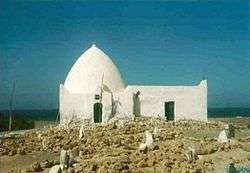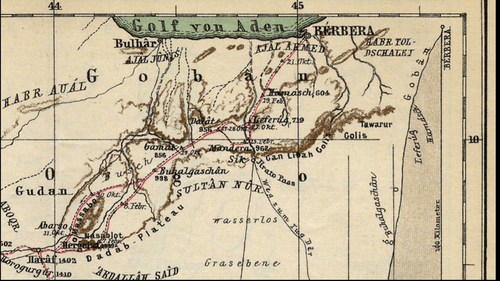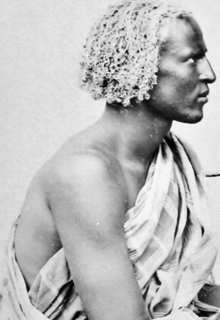Habar Yoonis
The Habar Yoonis (Arabic: هبر يونس) are a Somali clan, part of the larger Isaaq clan family. Members of this clan are concentrated in the northwestern Somaliland, autonomous and self declare independent region, officially recognized as part of Somalia. Habar Yoonis is part of the 4 principal clans of the Isaaq clan.[1] Two (Habar Yoonis and Eidagale) of the four principal Isaaq clans are part of the Garhajis confederation, the largest and most widespread of the Isaaq clan. The Habar Yoonis is considered the biggest tribe within the borders of Somaliland.[2][3]
| Regions with significant populations | |
|---|---|
| Languages | |
| Somali and Arabic | |
| Religion | |
| Islam | |
| Related ethnic groups | |
| Habar Jeclo, Habar Awal and other Isaaq clans |
Distribution
The Habar Yunis inhabit all regions of Somaliland, with the exception of the Awdal region that borders Djibouti. The ancestral territory of the Habar Yoonis includes Burco and the Aroori plain.
The Habar Yoonis can also be found in considerable numbers in the Sanaag region and its regional capital of Ceerigaabo, Berbera, Hargeysa, and the Oodweyne, Sool and Mudug regions.
In the Hawd & the Reserved Area, the Habar Yoonis, together with their Eidagale kinsmen, populate much of the major towns and trading cities, the most promiment and emerging of the latter being Gashamo.[4][5]
Ancestry
Sa'id is the ancestor of the Habar Yunis . The Habar indicates a bah alliance or a uterine alliance. The Habar Yunis is a bah alliance of all the descendans of Arre Sa'id. Yonis the first born 'urad of 'ismail has given his name to the alliance.
His descendants are the most widespread and numerous compared to his brother Muse and 'Abdalla. The Habr Yunis descend from Sheikh Ishaq bin Ahmad descendant of 'Ali bin Abu Taleb. The Habr Yunis have the honour and responsilbity of taking care of the ancestors tomb, they are the custodians of his tomb.[6]

History
Sultanate of the Habr Yunis

The Habr Yunis Sultanate was a Somali Kingdom that ruled parts of the Horn of Africa during the 18th and 19th centuries. The Kingdom's territory encompassed the lands settled by the Habr Yunis tribe of the Garhajis clan. The Habr Yunis Sultans received a tax in the form of an annual tribute of livestock from their subjects and they regularly taxed the trade caravans that went through their territory. Moreover, the sultanate had a significant standing army which was used to enforce the taxation, as well as to defend their realm.[7][8]
The first Habr Yunis chief to assume the title Sultan was Sugulleh Ainanshe of the Ismail Arrah clan, his father Ainanshe was a traditional chief. Sugulleh was succeeded by his son Diriyeh Sugule in the late 18th century. Sultan Diriyeh reigned for more than 50 years and was eventually succeeded by his grandson Hersi Aman. Hersi is most notable for expanding Habr Yunis territory in the Haud and for engaging the first Rer Sugulleh civil war which resulted in his death. Sultan Hersi's death caused a decade-long civil war when his nephew Nur was crowned Sultan and his great uncle Awad Sultan Deriyeh and eldest living son of sultan Deriyeh declared himself a rival sultan in 1881.The two Sultans were now at war with each other and divided the Kingdoms territory between themselves, with Nur being based in the Toyo plains and Awd establishing himself at Burao. In the 1890s Sultan Awad was killed in a battle which resulted in Sultan Nur facing no opposition and was the sole ruler of the Habr Yunis Sultanate up until he started the Dervish uprising, which resulted in his uncle Madar Hersi being crowned. The Habr Yunis were now divided into two factions: pro-Dervish and anti-Dervish, the former being ruled by Sultan Nur and the latter the newly crowned Sultan Madar. After Nur's death in the Dervish camp, the Habr Yunis elders crowned his son Dolal, and with the Dervish defeat none of his heirs succeeded him leaving Madar's descendants as the undisputed Sultans of the Habr Yunis.[9][10]
Sultans of the Habr Yunis
| Name | Reign
From |
Reign
Till | ||
|---|---|---|---|---|
| 1 | Ainasha Hersi (traditional chief) | |||
| 2 | Sultan Sugulleh Ainasha (first sultan) | |||
| 3 | Sultan Diriyeh Sultan Sugulleh Ainasha | |||
| 4 | Sultan Hersi Aman Sultan Diriyeh | |||
| 5 | Sultan Nur Ahmed Aman Sultan Diriyeh | |||
| 6 | Sultan Awad Sultan Diiriye | |||
| 7 | Sultan Dolal Sultan Nur | |||
| 8 | Sultan Madar Hersi Sultan cabdale | |||
| 9 | Sultan Ali Sultan Madar Hersi | |||
| 10 | Sultan Osman Sultan Ali Sultan Madar |
Notable people
- Abdirahman Ahmed Ali Tuur, first president of Somaliland and second vice-president.
- Amina Moghe Hersi, notable business tycoon of Kenya, Uganda and Africa at large.
- Abdirahman Mohamed Abdullahi, leader and founder of the Waddani party.

References
- Horn of Africa. Horn of Africa Journal. 1997.
- "I.M Lewis, A pastoral democracy, p. 10".
- A General survey of the Somaliland protectorate 1944-1950, p.122, table 18
- "Violent deeds live on: landmines in Somalia and Somaliland, p. 63". |
- "I.M Lewis : peoples of the Horn of Afrcia". |
- Lewis, I. M.; Samatar, Said S. (1999). A Pastoral Democracy: A Study of Pastoralism and Politics Among the Northern Somali of the Horn of Africa. LIT Verlag Münster. ISBN 978-3-8258-3084-7.
- The Journal of The anthropological institute of Great Britain and Ireland| Vol.21 p. 161
- Journal of the East Africa Natural History Society: Official Publication of the Coryndon Memorial Museum Vol.17 p. 76
- Cosmos: communicazioni sui progressi recenti e notevoli della geografia e delle scienze affini di Guido Cora p. 201
- British Somaliland by Drake Borckmen, p. 79 - 82, 1912